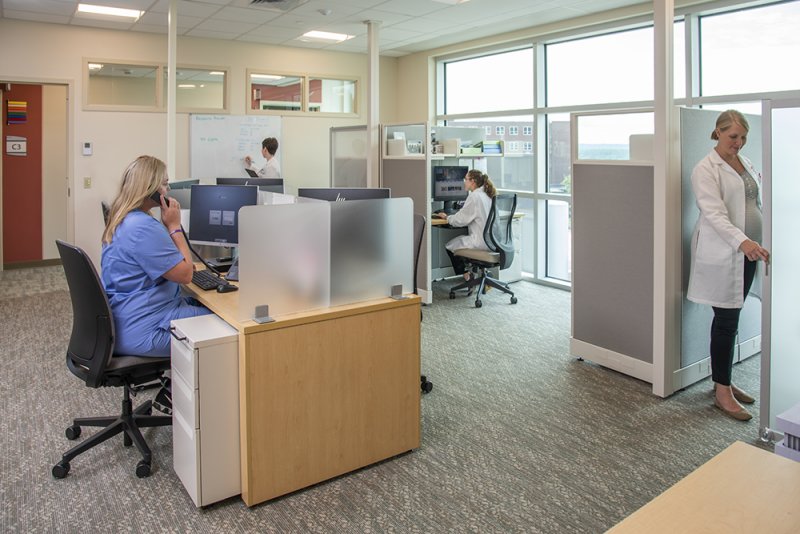 Team room at Concord Hospital’s new medical office building, designed by Lavallee Brensinger Architects. Photo by Studio One.
Team room at Concord Hospital’s new medical office building, designed by Lavallee Brensinger Architects. Photo by Studio One.
While an emphasis on natural beauty and energy efficiency has increasingly influenced design in recent years, architects are now coming up with new ways to shape a post-pandemic space, even as the pandemic influences the types of projects being built.
Building projects making it through the pandemic pipeline include health care facilities, schools (both K-12 and higher ed), civic projects like fire stations and town halls, senior living and general housing projects, and corporate science and technology labs, according to Richard Pizzi, CEO of Lavallee Brensinger Architects in Manchester.
Pizzi, the firm’s head of health care design, says health care, housing, and science and tech are the hottest markets right now. “Those three markets are fueling the construction economy,” he says.
Banwell Architects in Lebanon has seen a significant increase in demand for lab space. In the Lebanon and Hanover region, there are a number of new science and technology companies the firm helped to design.
While it may seem natural that a pandemic would spur a boom in health care facilities, Pizzi says that sector was already thriving before 2020.
Housing Demand
The housing market is also strong, given substantial ongoing supply constraints. “We’re always seeing a need for affordable housing,” says Mark Moeller, a principal architect at JSA Design in Portsmouth. He says there’s a forgotten population of middle-income workers who are being left out of the housing market, but developers are struggling to keep up with the demand due to land scarcity.
New Hampshire Housing Finance Authority stated in its market snapshot released in December that much of that scarcity is created artificially by the overregulation of housing development at the local level.
“There’s a multitude of challenges that developers have,” Moeller says. But he has found a niche in designing senior living projects, which face fewer local barriers as seniors aren’t seen as a burden on the school systems or area traffic. For the past eight years, JSA has designed close to half a dozen memory care facilities for a client in southern NH and Massachusetts.
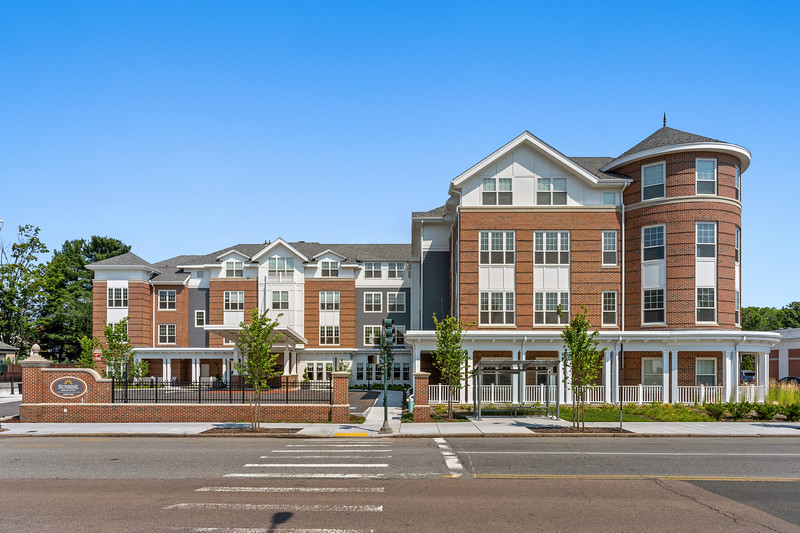 Sunrise of Newton, designed by JSA Design, features 85 assisted living and memory care suites. Courtesy photo.
Sunrise of Newton, designed by JSA Design, features 85 assisted living and memory care suites. Courtesy photo.
Now, Moeller sees ongoing demand for a greater mix of senior living projects that cover the continuum of care as well as independent living. He says most projects have 70 to 90 units, of which about 25 are for memory care or skilled nursing.
One of the reasons why developers are making more mixed projects like these is seniors are looking for a facility where they can age in place and transition to more assisted living units as they get older, says Moeller.
Schools
Civic and school projects are expected to see strong demand for years to come. Pizzi says there was a slowdown in 2020 with some municipal projects delayed as votes on major bonds were put off until 2022 in several communities. But that’s only a temporary blip in a larger arc of high demand, he says.
Also, federal and state funds are more readily available for projects like schools, according to Ingrid Nichols, the managing partner at Banwell Architects in Lebanon.
Eventually, the newly signed federal infrastructure money will make its way to NH developers. But some federal money from the Elementary and Secondary School Emergency Relief (ESSER) Fund, American Rescue Plan Act (ARPA) and loosened up state funding for school building projects is already available to municipalities looking to build new facilities or renovate existing ones, Nichols says.
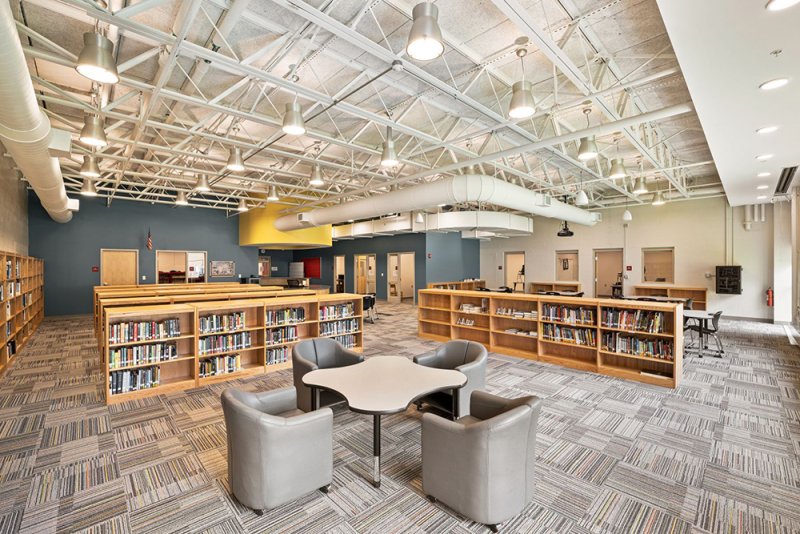 The library at Newmarket High School, designed by Banwell Architects. Courtesy photo.
The library at Newmarket High School, designed by Banwell Architects. Courtesy photo.
“We have basically never been busier,” she says. “There are a ton of public projects that are getting ESSR money and ARPA funds.” About 80% of Banwell’s projects are public projects such as schools. The firm also designs commercial, housing and other institutional and municipal projects.
Unexpected Arts Demand
Businesses and nonprofits forced into a holding pattern by the pandemic have used that time to plan renovation projects.
Nichols has seen this particularly with local art centers and theaters.
Banwell is currently working on four different theater renovation projects including the New London Barn Playhouse, the Lebanon Opera House and the White River Valley High School Auditorium. “That was a shock that kind of came out of left field,” Nichols says.
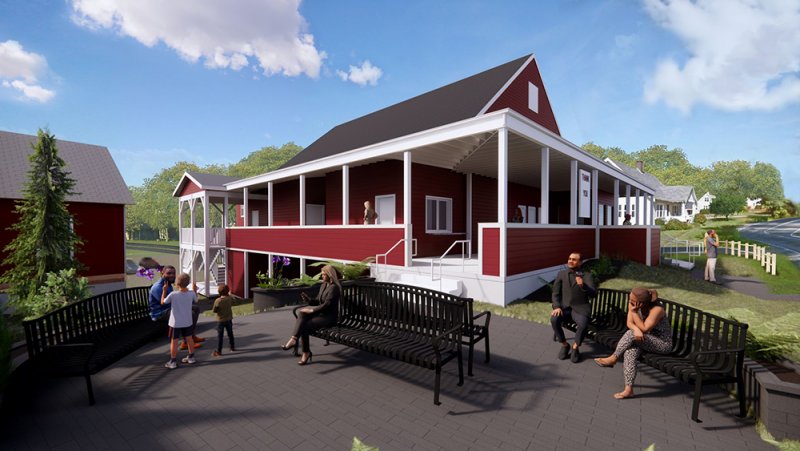 A rendering of the New London Barn Playhouse, designed by Banwell Architects. Courtesy image.
A rendering of the New London Barn Playhouse, designed by Banwell Architects. Courtesy image.
Mixed-Use and Adaptive Reuse
Lately, developers have been responding to a cultural shift toward mixed-use projects with housing, recreation and amenities that target both young and older childless adults who want to live, work and play in their local communities, says Andrew Holton, senior advisor at Lansing Melbourne Group (LMG).
Rather than just having a clubroom or a common lounge area, developers are bringing in local craft food businesses that supply artisanal baked goods, coffee and other items through dine-in areas or micro-lease distribution counters.
Banwell’s project manager Brad Prescott says adaptive reuse of old, small-town landmarks, such as old general stores, is also more popular. In at least three such examples, Prescott says wealthy benefactors in town are bankrolling contractors and architects to redesign the spaces for more restaurant and cafe uses to preserve the buildings and create community
gathering spaces.
All of these projects have combined to create a longer list of smaller projects for the 10-person firm. Nichols says while they’ve typically had about 15 projects in the works at once, they now have about 30.
Where Demand is Lower
Some traditional sectors are not as robust. Nichols and Prescott say they see significantly less demand for brick-and-mortar banking institutions given the growing popularity of digital banking.
The same is also true for traditional retail stores, they say, and for the same reasons. Amazon and other online buying and shipping services have driven developers away from stores that sell products in favor of businesses that provide food or services.
Design Trends
A growing trend is incorporating more “biophilic” design elements. In other words, architects are taking inspiration from nature. Whether that’s more natural light, plants and water features or creating patterns from the outdoors, like the unique shadows cast by birch trees, the idea is to embrace the beauty of nature. This also sometimes means developing larger outdoor lawns, parks or decks to enjoy.
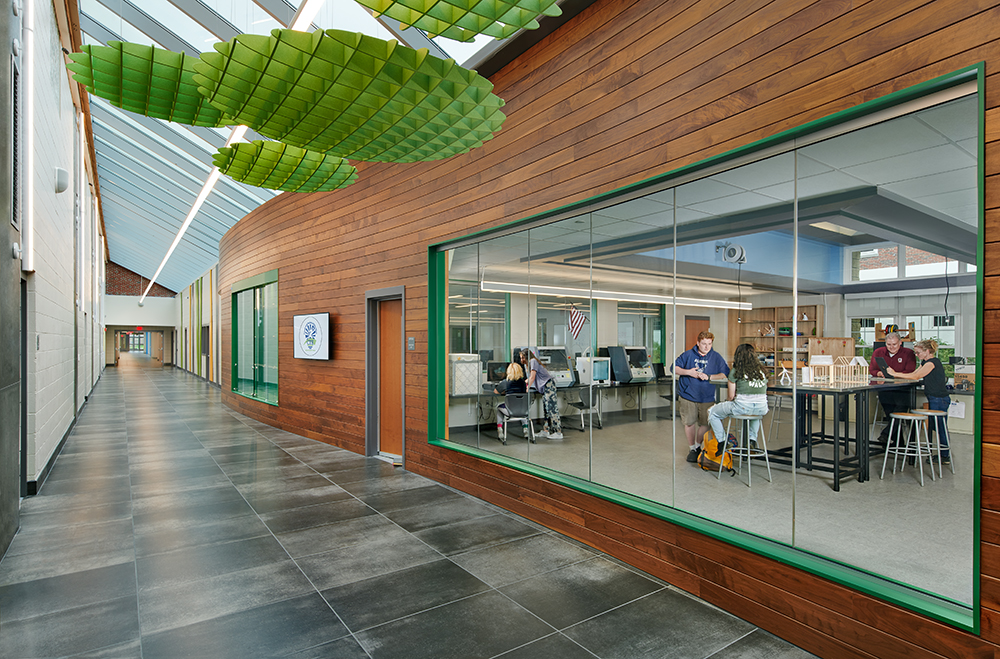 The Wilbur H. Palmer Career & Technical Education Center, designed by Lavallee Brensinger, incorporates biophilic design elements. Photo by Blind Dog Photo Associates.
The Wilbur H. Palmer Career & Technical Education Center, designed by Lavallee Brensinger, incorporates biophilic design elements. Photo by Blind Dog Photo Associates.
Pizzi says people have become increasingly interested in creating a sense of place and an improved “customer experience,” so architects have incorporated more natural light, fresh air, easy access and more aesthetically pleasing facades.
In senior living spaces, Moeller says they are creating common areas that are easy for residents to “preview” before entering, whether that means multiple entrances or greater visibility inside. There is also a shift away from a single dining hall to having multiple smaller dining areas with cafe and bistro concepts. “That’s another trend that a lot of our clients have embraced,” Moeller says.
And recognizing that a building’s use will change over time means designs must be flexible, Pizzi says.
Nichols says exposed ceilings have also been more popular in both schools and commercial spaces because this provides convenience in accessing utilities, more evenly distributed light, a more “industrial tech feel” and also helps with airflow. Air quality has been a significant concern among school districts looking to make classrooms safer in the era of COVID, and they have been updating facilities accordingly, Nichols says.
The COVID Effect
Before the pandemic, Prescott says clients were more concerned with efficiency, keeping buildings “tight” and reducing leakage and air loss. But he says there’s now increased interest in airflow.
One development Nichols and Prescott attribute to the pandemic is an increased willingness to pay more to improve the look of indoor spaces. “If anything, the pandemic has made clients more aware of the aesthetics and pushed them to spend a little more on it,” Nichols says.
Where traditional Yankee frugality might have skewed architecture toward the utilitarian, a new influx of urban elites escaping highly dense cities for northern suburbs are bringing a different, and more expensive, expectation of what they want from their built environment.
Office interior designs have also been affected by the pandemic. Prescott says commercial tenants are using more movable desks and accoustically separated booths that can be used as needed. “The size of the space may not get smaller. It will probably be the same size,” Prescott says. “They’re using their spaces much more efficiently than ever before.”
Pizzi says offices may be seeing fewer workers these days as a greater share work remotely or come to the office part time, but many companies are still preparing for a time when everyone is back again. Pizzi also says the sudden popularity of video conferencing has created a new focus on acoustics, leading architects to design medium-sized conference rooms and phone-booth-like enclosures for people to communicate digitally without distraction.
Moeller says they’re starting to respond to virus safety concerns at senior living communities by designing small meeting spaces closer to entrances, so visitors interact with fewer residents.
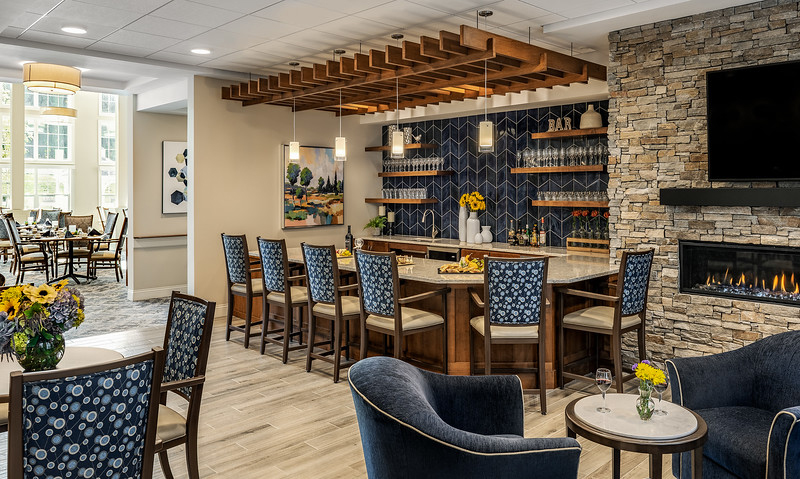 The bistro at The Woods at Merrimack retirement community in Methuen, MA, designed by JSA Design. Courtesy photo.
The bistro at The Woods at Merrimack retirement community in Methuen, MA, designed by JSA Design. Courtesy photo.
The cost of building materials has skyrocketed due to global supply shortages and shipping delays. “It is the worst I’ve seen in 27 years,” Pizzi says.
New Hampshire Housing reported the price index for softwood lumber peaked in May 2021. By October, it had dropped 50% but is still above average. Nichols says the lumber market seems to be stabilizing and construction is rebounding. But the uncertainty around the global supply chain has made developers more source conscious, and it has also become a factor in
hiring contractors.
“Owners now are really focusing on the construction managers’ particular value in how they can problem solve and change their tactic if they can’t get a certain material,” Nichols says.
The pandemic has also changed how architects work with one another. Pizzi says the increase in virtual collaboration has made it easier to share plans with clients and attend public hearings with less distraction. But he fears it is making it harder for young architects to collaborate and learn from one another. “In the architectural world, we rely very much on collaboration and mentorship,” Pizzi says. “It takes a long time to be a good architect.”

 Current Issue - May 2024
Current Issue - May 2024